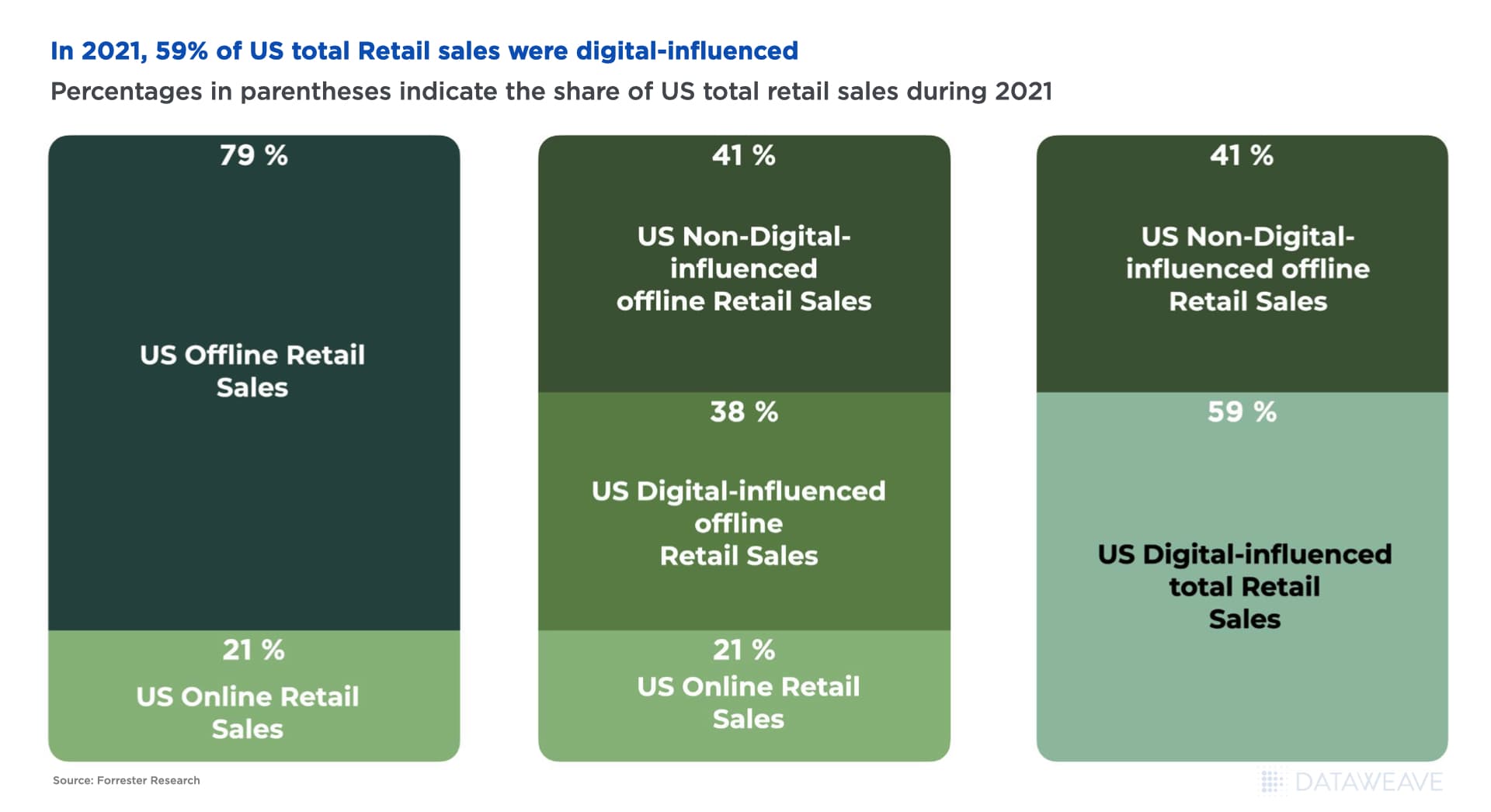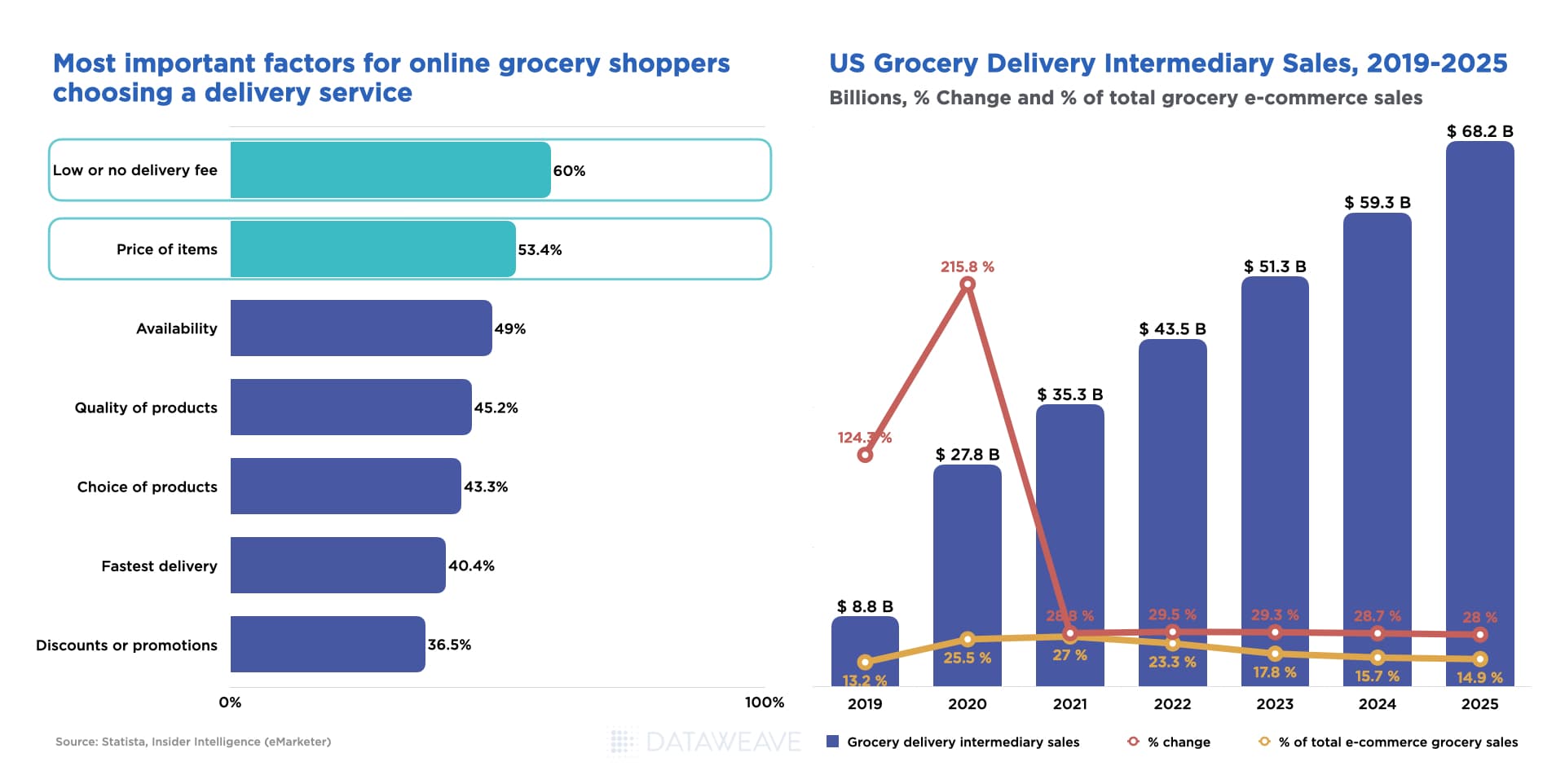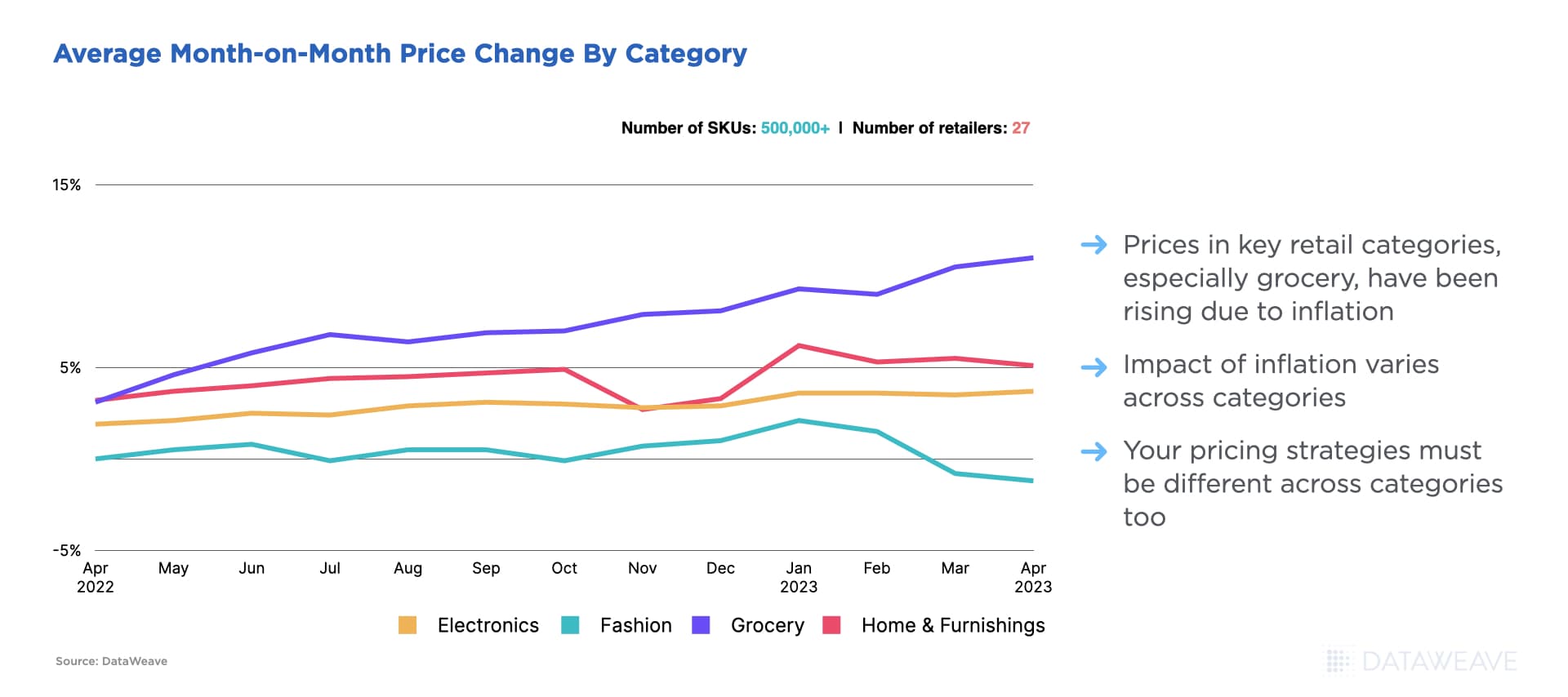What’s in the article:
- Introduction
- The importance of relative pricing and staying competitive
- Why do retailers (online, offline, and omnichannel) need to pay attention to digital channels to maintain competitive pricing?
- Problems with DIY Competitive Intelligence Systems
- Introducing DataWeave's Competitive Pricing Intelligence Solution Stack
- Why you need to leverage the Power of Competitive Price Tracking
In today's rapidly changing retail landscape, consumers are wielding their purchasing power like never before. The biggest purchase making factor? Price! While it might be tempting to think that price competitiveness primarily affects online stores, a growing trend of comparing eCommerce and offline prices highlights that traditional brick-and-mortar and omnichannel retailers are equally impacted.
An eye-opening finding from a Forrester analysis brings to light the significant role of digital influence, shaping a remarkable 59% of the entire landscape of retail sales in the United States in 2021. This emphasizes that consumers, regardless of whether they're shopping online or in-person, consistently give weight to pricing considerations. The substantial impact of digital channels on retail transactions solidifies the central role of pricing in the competitive arena.

Modern consumers are armed with smartphones and easy access to information, making them savvy shoppers who actively seek the best deals and incentives. With a wealth of information at their fingertips, consumers increasingly take the time to compare prices across different retailers, both online and offline, before making their final purchase decisions.
The importance of competitive pricing as a driving force in this new retail landscape cannot be overstated. When we consider the backdrop of inflationary pressures spanning 2022-23, consumers become even more attuned to price sensitivity due to tighter financial circumstances. A survey by Statista, targeting US online users, unveils a clear fact: 70% of participants highlight competitive pricing as the key factor influencing their choice of online retailers.

Regardless of whether consumers are engaging with marketplaces like Amazon, shopping in physical stores like Target or Walmart, or using delivery services like Instacart, the common thread is their inclination to research product details, prices, and reviews across various platforms before making a decision. As a result, strategically aligning price competitiveness and optimization across these channels becomes a crucial mandate for retailers of all types.
In the ever-shifting landscape of consumer behavior, the pivotal roles of competitive pricing, free shipping, and data-driven insights stand out prominently. Visionary leaders such as CEOs, CFOs, COOs, merchandisers, managers, and other retail stakeholders are already recognizing the transformative potential of these elements. They are harnessing the power of price optimization tools to secure a competitive edge in the industry. However, relying solely on internal data for tracking and analysis falls short. Amid the dynamic macroeconomic environment, the positioning of your competitive pricing takes center stage. To claim the role of a price leader and maintain a position of innovation, leveraging comprehensive competitive insights becomes imperative.
Join us in this article as we delve deeper into the evolving consumer behavior trends across the retail landscape, and the impact of competitive pricing. We uncover the crucial role of data in shaping the future of retail. Together, let's look at the changing consumer dynamics and unlock new opportunities for growth and success.
The importance of relative pricing and staying competitive
Retailers must recognize the significance of relative pricing and staying competitive in this price-sensitive landscape. With consumers actively comparing prices both online and offline, businesses need to continually monitor and adjust their pricing strategies to remain competitive. This is especially relevant when retailers need to defend margins but also cater to consumer demand, while maintaining a competitive position in relation to other players in the marketplace.
Competitive price tracking empowers businesses to meet these consumer expectations head-on. By continuously monitoring the prices of their competitors and assessing their delivery offerings, retailers can optimize their pricing strategies and ensure they remain attractive to cost-conscious shoppers. They can identify opportunities to provide free or expedited delivery options, thereby increasing customer satisfaction and loyalty.
The changing consumer behavior landscape necessitates robust competitive price tracking at scale. The rise of digitally influenced sales, the growth of delivery intermediaries, inflationary pressures, and consumer preferences for lowest priced items with free or quick delivery all underscore the importance of closely monitoring and analyzing pricing dynamics. Businesses that leverage comprehensive competitive price tracking solutions can gain a competitive edge, respond effectively to market shifts, and cater to the evolving needs of their price-conscious customers.
Why do retailers (online, offline, and omnichannel) need to pay attention to digital channels to maintain competitive pricing?
In today's fiercely competitive retail landscape, retailers, be it online, offline, or omnichannel, must pay meticulous attention to digital channels in order to effectively maintain growth. Neglecting the digital realm would be akin to attempting to sell vintage vinyl records at a silent disco—an incongruous and out-of-sync approach that disconnects from the evolving preferences of contemporary shoppers. By embracing digital channels, retailers can tap into the dynamic e-commerce marketplace, align themselves with the expectations of tech-savvy consumers, and secure a competitive edge by offering compelling pricing options that resonate with the online shopping community. Here are a few global trends that shape consumer behavior and make it crucial for retailers to optimize pricing at scale.
Digital Influences Not Just eCommerce But Also Omnichannel, Offline Sales
According to a comprehensive study by Forrester, digital influence has dramatically reshaped the dynamics of in-store sales. In fact, Forrester expects US digital-influenced retail sales to grow from $2.7 trillion in 2022 to $3.8 trillion in 2027. In an era where digital technology permeates every aspect of our lives, its influence has extended far beyond the realm of online shopping. The power of digitally influenced sales has emerged as a game-changer for offline and omnichannel retailers, capturing the attention of retail stakeholders worldwide.
Consumers now embark on a digital journey before setting foot in a physical store, using online resources to research products, compare prices, and read reviews. This digital influence not only shapes their expectations but also impacts their in-store purchasing decisions. Recognizing this, retailers have started investing in online channels to create a seamless, omnichannel experience that leverages the power of digital influence. The integration of online and offline strategies has become paramount to drive customer engagement and increase conversion rates.
Imagine this scenario: Sarah, a tech-savvy consumer, finds herself in need of a new pair of running shoes. Before even stepping foot inside a physical store, she whips out her smartphone and embarks on a digital quest for the perfect pair. She reads reviews, compares prices, and explores different options, all with a few taps and swipes. She knows exactly what she wants, what price point is acceptable to her, what discounts she can avail, and has probably compared her choice on online stores before she studies the product offline. By the time she arrives at the store, she is armed with knowledge and a clear intent to make a purchase.
The benefits are far-reaching. Essentially, retailers can leverage the power of digital influence to drive foot traffic, increase customer engagement, and ultimately boost sales. For retail stakeholders, recognizing and harnessing the power of digitally influenced sales is not just a strategic advantage; it's a means to the ability to thrive in a rapidly evolving retail landscape.
Consumers Check Competitive Pricing, Purchase Lowest Priced Products
In a recent study conducted by Statista, consumer decision-making factors were examined in detail. While 70% of respondents mentioned competitive pricing as the decision making reason to choose a retailer, 62% chose free shipping. These aspects emerge as the primary factors influencing purchase decisions across a wide range of products and industries.
Consumers are not only seeking the lowest prices but also expecting the convenience of free shipping, highlighting the necessity for retailers to align their pricing strategies with these preferences. Moreover, this shift in consumer behavior underscores the indispensability of consistent data tracking and analysis in enabling retailers to understand and respond effectively to these evolving demands.
For retailers, the implications of this shifting consumer behavior are profound. It is no longer sufficient to focus heavily on in-store operations; they must embrace the digital revolution and weave it into their strategies. By investing in online channels, enhancing their digital presence, and leveraging technology, offline retailers can tap into the vast potential of digitally influenced sales. This means providing robust online platforms, offering seamless omni-channel experiences, and embracing data-driven insights to understand consumer behavior.
Whether it's online or offline, the desire for competitive pricing and free shipping has become a decisive factor in consumer purchase decisions. This shift in consumer behavior has compelled retailers to adapt their strategies to meet these new expectations. The implications of this behavior are significant for retailers striving to stay ahead in a hypercompetitive marketplace.
The Rise of Delivery Intermediaries Has Created Increasing Price Awareness
In today's hypercompetitive retail landscape, consumers worldwide have become more conscious of competitive prices when making purchase decisions. This shift in consumer behavior extends beyond online shopping to the aisles of physical stores. Moreover, thanks to the growth of delivery intermediaries like Instacart, DoorDash, Uber, etc, comparative shopping behavior receives a boost. According to an eMarketer report, US grocery delivery intermediary sales are expected to grow from $8.8 Bn in 2019 to $68.2 Bn in 2025.
The popularity of delivery intermediaries is highlighted by a Coresight Research survey that found that 60% online grocery shoppers choose a delivery service based on low or no delivery fees, while another 53.4% look at the price of products before making a purchase decision.

These intermediaries allow shoppers to compare prices and delivery options from multiple retailers at a hyperlocal level, ensuring they find the best deal without the hassle of visiting numerous physical stores. Therefore, competitive price tracking at scale across zip codes and multiple locations enables businesses to keep pace with this evolving landscape. By monitoring the prices offered by their competitors through these delivery intermediaries, retailers can adjust their pricing strategies to remain competitive. Additionally, they can identify opportunities for collaboration with these intermediaries to enhance their offerings and improve overall customer satisfaction.
Inflation Has Increased Price Comparison before Purchase
Inflationary pressures have led to a heightened emphasis on price comparison among consumers. Rising costs of goods and services have resulted in tighter budgets and a greater need to make every dollar count. DataWeave’s research into pricing across various categories between August 2022 to March 2023 show a consistent increase. Inflation and various corresponding factors have contributed to price increases across key categories. As a result, consumers are increasingly diligent in their search for the best prices before making a purchase.

Competitive price tracking provides businesses with the tools to navigate this inflationary landscape effectively. By closely monitoring market trends and pricing fluctuations, retailers can identify opportunities for cost optimization without compromising on quality. They can adjust their pricing strategies, negotiate better deals with suppliers, and offer compelling promotions to cater to price-sensitive consumers. This ability to stay ahead of the inflation curve is crucial for maintaining customer loyalty and capturing market share.
Problems with DIY Competitive Intelligence Systems
While the importance of competitive intelligence is widely acknowledged, many businesses attempt to tackle it through do-it-yourself (DIY) methods. However, these self-built systems often encounter a range of challenges that hinder their effectiveness and limit their potential. Let's delve into some of the problems associated with DIY competitive intelligence systems.
- Subpar Data Quality: DIY systems may struggle to aggregate accurate and comprehensive data. Obtaining high-quality data from various sources and platforms requires significant effort and expertise. Inadequate data collection processes can result in incomplete or inaccurate information, undermining the reliability and usefulness of the intelligence gathered.
- Inability to Scale: As businesses grow and expand their operations, DIY competitive intelligence systems often fail to scale alongside them. These systems may lack the necessary infrastructure and technology to handle increasing data volumes and complexities. Limited scalability restricts the ability to track and analyze a wider competitive landscape, potentially missing crucial market insights.
- Synthetic Data Challenges: Accurately matching products across different retailers and platforms is a complex task in competitive intelligence. DIY systems often struggle with sophisticated product matching algorithms, leading to incomplete or incorrect comparisons. This limitation hampers the accuracy and reliability of pricing data, impeding decision-making processes.
- Poor Integration with Internal Systems: Integration with existing internal systems is crucial for seamless adoption and utilization of competitive intelligence. DIY systems may face compatibility issues, making it challenging to integrate with other data sources or internal workflows. This lack of integration hinders the efficient utilization of intelligence insights within the organization.
- Lack of Agility: The competitive landscape is constantly evolving, requiring businesses to be agile in their decision-making. DIY systems, which rely on manual data collection and analysis processes, are inherently slow and time-consuming. By the time insights are obtained, they may no longer be relevant, impeding timely actions to capitalize on market opportunities or mitigate threats.
- Sloppy Support and Maintenance: Building and maintaining a competitive intelligence system in-house can be demanding. DIY solutions often lack dedicated support and maintenance, resulting in challenges when issues arise. Businesses may struggle to allocate resources and expertise required to address technical glitches, ensure data accuracy, and keep the system up-to-date.
In light of these challenges, businesses can benefit from a comprehensive competitive pricing intelligence solution stack like DataWeave. By leveraging accurate data aggregation at scale, sophisticated product matching algorithms, and ease of actionability, DataWeave empowers businesses to overcome the limitations of DIY systems.
With DataWeave's solution stack, businesses can access high-quality data, achieve seamless integration with internal systems, and gain agility through real-time alerts and notifications. Additionally, DataWeave's robust support and maintenance ensure uninterrupted operations, allowing businesses to focus on leveraging competitive intelligence for strategic decision-making.
Introducing DataWeave's Competitive Pricing Intelligence Solution Stack
Creating and nurturing a pricing strategy is one of the biggest challenges for a retailer. All retailers have to do the tightrope walk between increasing the GMV (gross merchandize value) at all costs versus defending the margins. In the case of online retailers where the price changes are dynamic, it becomes even more challenging. Retailers have started adopting pricing intelligence solutions that provide competitor data at a SKU by SKU granularity.
While the pricing intelligence solution provides pricing changes across retailers, the pricing functions need to keep track of how these price changes are happening over long periods of time and how the pricing strategy needs to be tweaked accordingly. DataWeave’s competitive pricing intelligence stack allows retailers to manage both these aspects.
While Dataweave’s Pricing Intelligence solution provides the pricing operations team with the relevant data and insights at an operational level, the pricing dynamics dashboard helps the pricing heads and business unit heads to check what the competitive pricing strategy is, how often are they changing prices, who is the price leader and follower etc. Here are some key features of the DataWeave Pricing Competitive Intelligence Solution Stack that can help retailers stay on top of competition.
Accurate Data Aggregation at Scale
In the realm of competitive intelligence, accurate and comprehensive data is the lifeblood of informed decision-making. DataWeave's competitive intelligence solution stack goes beyond conventional data aggregation methods, offering businesses unparalleled access to a rich tapestry of information. Our capabilities extend to complex web and mobile apps data aggregation, providing businesses with a comprehensive understanding of the market at various levels, from store-level insights to hyperlocal data.
Moreover, DataWeave's data collection capabilities extend to different levels of granularity. From store-level insights to ZIP code-level data and hyperlocal information, we provide businesses with a comprehensive understanding of their target markets. This level of granularity allows for localized pricing strategies, hyper-targeted marketing campaigns, and enhanced customer engagement.
Another advantage of DataWeave's solution stack is its language-agnostic nature. We have developed our technology to extract and process data from diverse languages, making it a versatile solution for businesses operating in global markets. Regardless of the language in which the data is presented, our technology can accurately collect, validate, and analyze it, ensuring that businesses can harness the power of competitive intelligence worldwide.
Sophisticated Product Matching: Unlocking Insights through Accurate Matching
Product matching is a complex task in competitive intelligence, often presenting businesses with significant challenges. Variations in product titles, descriptions, and attributes across different retailers and platforms make it difficult to accurately match products. Inconsistent naming conventions, misspellings, abbreviations, and other discrepancies further complicate the process. The inability to effectively match products hampers the accuracy and reliability of pricing data, limiting the insights that businesses can derive from competitive intelligence.
DataWeave's competitive intelligence solution stack rises to the challenge of product matching through the application of advanced algorithms and machine learning techniques. Text parsing and normalization are integral to our product matching capabilities. Through intelligent parsing, we break down textual information into structured data, enabling precise identification of product attributes such as brand, model, size, color, and more. Additionally, normalization ensures consistency in the representation of product information, eliminating inconsistencies in spellings, abbreviations, and formatting.

The result of DataWeave's sophisticated product matching techniques is a highly accurate and comprehensive dataset. Businesses can confidently compare prices, track competitors' offerings, and identify market trends with a level of precision previously unattainable. Accurate product matching empowers businesses to make data-driven decisions based on reliable intelligence, allowing them to optimize pricing strategies, identify product gaps, and stay ahead of their competitors.
Actionable and Strategic Industry Insights via Dashboards
DataWeave's competitive intelligence solution stack goes beyond providing raw data—it delivers valuable strategic industry insights. By analyzing and interpreting the vast amount of information, we unveil hidden patterns, trends, and opportunities that can drive your business forward through a bunch of customizable dashboards.
In fact, using these dashboards, our solution stack enables you to gain a holistic view of your industry, identify key competitors, and assess their pricing strategies, promotional campaigns, and market positioning. By benchmarking against competitors, you can gauge your performance, identify gaps, and develop strategies to stay ahead. The pricing dynamics dashboard, for instance, helps the pricing heads and ecommerce heads get a birds eye view on the pricing at an industry level. The key insights it provides include:
- Price Leadership: DataWeave's competitive intelligence solution stack offers valuable insights into price leadership within various categories and how it evolves over time. By identifying the price leaders across different segments, businesses gain a comprehensive overview of competitors' pricing strategies. This understanding allows retailers to strategically position themselves as price leaders in certain categories while maintaining healthy profit margins in others.
- Price Change Summary: Our solution stack provides an overview of price changes over a specific period, enabling businesses to track how competitors adjust their pricing. By quantifying these changes in percentage terms, businesses gain valuable insights into the extent of pricing adjustments. This comprehensive overview empowers retailers to make data-driven decisions and respond effectively to market dynamics.
- Monthly Price Change Frequency to gauge Pricing Dynamism: The monthly price change frequency metric offers a snapshot of how frequently prices fluctuate among retailers. This crucial information provides businesses with an understanding of the dynamic nature of pricing strategies and allows them to benchmark their own pricing practices against competitors. By identifying their position in terms of price change frequency, retailers can assess their agility in responding to market demands and make informed decisions accordingly.
- Price Decrease and Price Increase Opportunities: DataWeave's solution stack helps businesses identify opportunities for price decreases and increases. By tracking the frequency of price decreases and increases, retailers gain insights into their own pricing actions. This knowledge empowers businesses to capitalize on moments where price adjustments can attract price-sensitive customers or maximize profitability. With a clear understanding of the pricing landscape, retailers can seize opportunities and fine-tune their pricing strategies accordingly.
- Action Rates - Leveraging Data-Driven Pricing Recommendations: Our solution stack provides visibility into the alignment between pricing recommendations and actual price changes. By monitoring the action rates, businesses can assess how often they implement pricing adjustments based on our recommendations. This insight enables retailers to evaluate their responsiveness to competitive intelligence and make informed decisions to drive business growth.
By leveraging these strategic industry insights, retailers can fine-tune their pricing strategies, enhance competitiveness, and seize growth opportunities. Our solution stack empowers you to make informed decisions based on a deep understanding of your market, competitors, and customers, propelling your business towards success in the dynamic landscape of today's industry.
Why you need to leverage the Power of Competitive Price Tracking
In the fast-paced world of retail, having the best optimization solutions and cutting-edge AI systems alone is not enough. The saying "garbage in, garbage out" holds true—without accurate and reliable data, any insights or actions derived from the system will be flawed. That's where the importance of consistent data tracking and analysis comes into play.
Throughout this article, we have explored the shifting consumer behavior landscape, highlighting the increasing significance of competitive price tracking. Consumers worldwide are actively seeking the best prices and prioritizing free or quick delivery options. This trend extends to both online and offline shopping, underscoring the need for retailers to stay ahead by harnessing the power of competitive intelligence.
DataWeave's competitive intelligence solution stack emerges as the key to unlocking this power. With accurate data aggregation at scale, encompassing complex web and mobile apps data, store-level insights, ZIP code-level analysis, and hyperlocal data, our platform enables businesses to track hundreds of thousands of SKUs across the competition seamlessly. Moreover, our language-agnostic capabilities ensure compatibility with diverse markets and regions, empowering businesses to expand globally while maintaining accurate insights.
Crucially, DataWeave's solution stack offers more than just data processing. Our advanced algorithms and machine learning techniques enable sophisticated product matching, ensuring high precision and recall rates. By parsing and normalization of textual information, we overcome the challenges of inconsistent product descriptions, abbreviations, and variations, allowing businesses to make accurate comparisons and derive meaningful insights.
The value of DataWeave's competitive intelligence solution stack goes beyond data aggregation and product matching. It encompasses strategic industry insights, competitive landscape analysis, benchmarking, and actionable recommendations. Businesses gain a deeper understanding of price leadership, price fluctuations, price change frequencies, and opportunities for price adjustments. Armed with this knowledge, retailers can fine-tune their pricing strategies, identify growth opportunities, and optimize their market position.
Looking ahead, the role of competitive price tracking will continue to be crucial in the evolving consumer behavior landscape. As the digital revolution accelerates and consumer expectations evolve, businesses need to remain agile and responsive. Competitive intelligence, powered by data tracking and processing, will be a vital tool for retailers to stay ahead of the curve, make informed decisions, and deliver value to their customers.
In conclusion, consistent data tracking and analysis form the bedrock of successful competitive pricing strategies. DataWeave's competitive intelligence solution stack offers accurate data aggregation at scale, sophisticated product matching, ease of actionability, and strategic industry insights. By harnessing the power of competitive price tracking, businesses can navigate the ever-changing consumer landscape, drive growth, and stay one step ahead of their competition. Embrace the future of pricing intelligence with DataWeave and unlock the true potential of your business.
Book a Demo
Login
For accounts configured with Google ID, use Google login on top.
For accounts using SSO Services, use the button marked "Single Sign-on".
